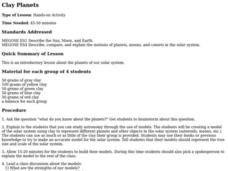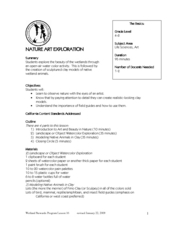University of Alaska
Clay Model Earth
What a great way to incorporate hands-on learning while teaching about the earth's layers. The class observes an overhead transparency (linked in Included Materials) as they create their own model Earth using different colors of clay....
Curated OER
Clay Planets
Have your class learn about the solar system using this hands on technique. Learners review what they know about the planets, and create a clay model of the solar system. There are a list of resource links to make this instructional...
University of Colorado
Clay Planets
Why do scientists use models? In the first installment of 22, groups create scale models of our solar system. They then share and discuss their models.
Teach Engineering
Building and Testing Model Underground Safety Caverns
Teams take their cavern designs and build a model from clay or paper mache that can be buried in sand. Testing involves dropping a bowling ball on the buried cavern. Teams dig out their cavern, inspect it for damage, and consider...
Texas State Energy Conservation Office
Investigation: Chemical Models
Science teams make models of four different hydrocarbon compounds that we commonly use for fuel. Then they demonstrate chemical reactions that result when energy is produced. This can be used as an enrichment when your class is studying...
Curated OER
Clay Planets
Students create scale models of the planets out of clay and compare them to the real planets.
Curated OER
Clay Ants: Insect Anatomy
Students examine anatomic structures in order to identify insects from other living organisms. They gain a level of comfort from anxiety when observing and handling live and pinned insects. They create clay models of an insect.
Curated OER
Modeling the Electromagnetic Spectrum
Learners construct a model of an electromagnetic spectrum using play-doh and string. They use exponents and plot the radio/microwave, infrared, and visible bandwidths of the spectrum.
Curated OER
How Can We Make a Model of Lungs?
Fifth graders examine the function of the lungs and create a model of the lungs. Using a plastic cup, drinking straw, plastic bag, small balloon, and a rubber band, they follow step-by-step directions to construct simulated lungs. ...
Perkins School for the Blind
Chromosome Models- Karyotyping
Create your own karyotypes with clay in a kinesthetic genome activity. This tactile experience was created for visually impaired pupils, but can be used for all hands-on learners who are beginning to study chromosomes. The preparation...
Curated OER
Folds in the Earth
Ninth graders demonstrate the forces that cause folds in the earths crust by use of clay modeling. They demonstrate there knowledge of terminology and concepts related to Earths folding processes by a written or oral report on data...
Curated OER
Atoms and Elements: An Introduction
Students are able to discuss the difference between a proton, a neutron and an electron. They also can explain the difference between an ionic and a covalent bond. Students know the main structure of atoms and molecules. Student are able...
US Environmental Protection Agency
Aquifer in a Cup
Young scientists create their very own aquifers in this science lesson on ground water. After learning about how some people get their drinking water from underground wells, young learners use sand, modeling clay, and aquarium rocks to...
Curated OER
Relative Age Dating
Modeling dough and paper cutouts in science class? Learn about how relative age dating concepts, like the Law of Superposition and cross-cutting relationships, can be used to describe the formation of sedimentary layers.
Curated OER
Nature Art Exploration
Students draw a nature landscape using watercolors. In this life science lesson, students share their personal experience on the beauty of nature. They create clay models of different native animals.
Curated OER
Clay Sculpture: Relationships
Students explore art history by conducting an in-class activity. In this sculpting lesson, students examine previously created art sculptures in a textbook. Students utilize clay, sculpting tools and grey paper to create their own...
Curated OER
Volcano Lava Recipe--Experiment and Model
Middle schoolers build a volcano of clay around a container that is thin and tall. They experiment with two containers with different mixtures in each. Students write out their findings and use strong adjectives to describe how the two...
It's About Time
How Do Plate Tectonics and Ocean Currents Affect Global Climate?
What do plate tectonics and ocean currents have to do with global climate? This fourth installment in a six-part series focuses on how plate tectonics and ocean currents affect global climate, both now and in the past, outlines an...
Curated OER
Models of Succession
Pupils create a model city in order to understand the effects human habitats have on the environment. For this environment lesson, students examine the effects human habitats have on the environment. Pupils create a model city and...
Curated OER
Gift for the Indians: Model of the Mayflower in the Ocean
Students build a miniature replica of the Mayflower. They make the boat float in a cup of water while studying the concept of gift giving on Feast Day.
Curated OER
ACTIVITY 6: MAKE A FOSSIL MOLD AND CAST and ACTIVITY 7: HOW BIG WERE PREHISTORIC ANIMALS?
Instructions for two terrific ancient history lessons for your primary paleontologists are provided in this resource. The first involves the creation of fossil cast replicas using plaster of Paris. The directions are detailed, but the...
Curated OER
Creating a 3d Model and Corresponding Topographic Map
Students create a landform model and topographic map. In this topography lesson, students use a real landform to create a model and topographic map to scale.
Curated OER
From Maps to Models
Students explore watersheds through the use of a topographic map. They observe topographical maps and discuss their characteristics. In groups, students create a model clay island and make a topographical map of it. Afterward, groups...
Curated OER
Edible Soils
Students create soil profiles, including rock, clay, silt, sand, and humus, in clear plastic cups out of edible materials.
Other popular searches
- Clay Modeling Sea Stars
- Clay Modeling Sculpture
- Clay Modeling Planets
- Clay Modeling Horses
- Clay Modeling Communities
- Clay Modeling Pigs
- Clay Modeling and Bartholdi

























